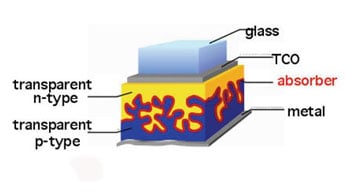Researchers in Germany have created a new type of very thin solar cell that could provide a cheaper alternative to existing solar cells. The device, built by Rolf Koenenkamp (now at Portland State University in the US) and colleagues at the Hahn Meitner Institute in Germany, consists of a light-absorbing layer placed on top of a “deep microstructure” substrate. The advantage of the device is that it can be made from smaller quantities of lower quality semiconductor material (K Ernst et al. 2003 Semicond. Sci. Technol. 18 475).

Most commercial solar cells use flat substrates on which a light-absorbing layer is deposited. The new device built by Koenenkamp and colleagues, however, consists of a cadmium-tellurium absorber layer deposited on top of a structured substrate made of porous titanium dioxide (see figure). When photons hit the absorber layer, they excite electrons into the conduction band of the material where they are registered as electrical current. Any stray photons are scattered back into this layer by the pores in the titanium dioxide. This creates an output current that is up to fifty times greater than in a substrate-cell made up of flat, non-porous material.
Using such a structured cell shortens the transport path for the photo-excited electrons which means that the material can be of a relatively low quality. The light path through the absorber, meanwhile, is enhanced through scattering which means that a higher proportion of incident sunlight is absorbed and that less material needs to be used in the cell.
The researchers found that a cadmium-tellurium layer 150-200 nm thick was sufficient to absorb most of the sunlight. The cell produces a voltage of 0.67 V and a current of 8.9 mA cm-2 when illuminated with 100 mW cm-2 of sunlight. This is comparable to conventional solar cells, which typically produce between 0.5 and 1 V. In addition, when the absorber was alloyed with mercury, the current was boosted by more than 50% to 15 mA cm-2.
“Although these cells are still less efficient than existing cadmium-tellurium solar cells, our results show that absorber material considered useless for flat cells can still give good output when highly structured substrates are used,” Koenenkamp told PhysicsWeb. “These findings may open the way to less expensive processes in photovoltaics.” The team now hopes to show that the same principle could be applied to other materials, such as amorphous silicon and compound solar cells.



